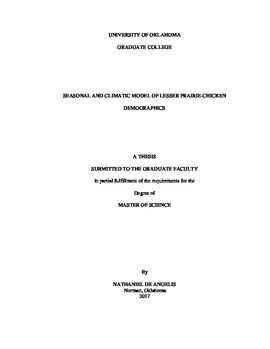| dc.contributor.advisor | Patten, Michael | |
| dc.contributor.author | De Angelis, Nathaniel | |
| dc.date.accessioned | 2017-05-09T20:15:21Z | |
| dc.date.available | 2017-05-09T20:15:21Z | |
| dc.date.issued | 2017-05 | |
| dc.identifier.uri | https://hdl.handle.net/11244/50734 | |
| dc.description.abstract | Abstract
The lesser prairie-chicken (Tympanuchus pallidicinctus) has suffered substantial losses in both population number and occupied range over the last century. Although the species has been the focus of range-wide conservation efforts, human activities such as agriculture and energy development continue to pose a threat to remaining populations. Potential changes in long-term weather patterns resulting from climate change will create new conservation challenges for lesser-prairie chickens in the coming decades. Investigating, describing, and predicting these impacts is essential to protecting the species and guiding management decisions. My work examines the effect of varying climate conditions on lesser prairie-chicken populations by means of a season-based demographic model.
By incorporating seasonality into the model, I found that the lesser prairie-chicken population in Oklahoma is likely not large enough to survive an increase in unfavorable climatic conditions. The probability of extirpation was very sensitive to climatic extremes and small increases in the frequency of drought conditions during summer months led to a nearly 50% increase in failure to meet sustainable population levels. Both positive and negative changes to climatic conditions during summer months had a more profound impact than changes to winter conditions. No level of increase in positive winter conditions was enough to counter the negative effects of even a mild increase in negative summer conditions. Scenarios modelling deviation away from average climatic conditions showed higher variation in final population size than scenarios with fewer extreme seasons. These results show that the lesser prairie-chicken is at risk of succumbing to environmental changes produced by climate change. Management efforts should focus on projects that increase nest success and decrease re-nesting attempts by adult females. Examples of potentially beneficial actions include placing mesh covers in or around known nesting sites to provide shelter and spraying scents near known nests that repel mammals and prevent depredation of nests.
Keywords: lesser prairie-chicken, climate change, seasonality | en_US |
| dc.language | en_US | en_US |
| dc.subject | Climate Change | en_US |
| dc.subject | Lesser Prairie-Chicken | en_US |
| dc.subject | Seasonality | en_US |
| dc.subject | Tympanuchus pallidicinctus | en_US |
| dc.title | SEASONAL AND CLIMATIC MODEL OF LESSER PRAIRIE-CHICKEN DEMOGRAPHICS | en_US |
| dc.contributor.committeeMember | Jeffrey, Kelly | |
| dc.contributor.committeeMember | Bridge, Eli | |
| dc.date.manuscript | 2017-05 | |
| dc.thesis.degree | Master of Science | en_US |
| ou.group | College of Arts and Sciences::Department of Biology | en_US |
